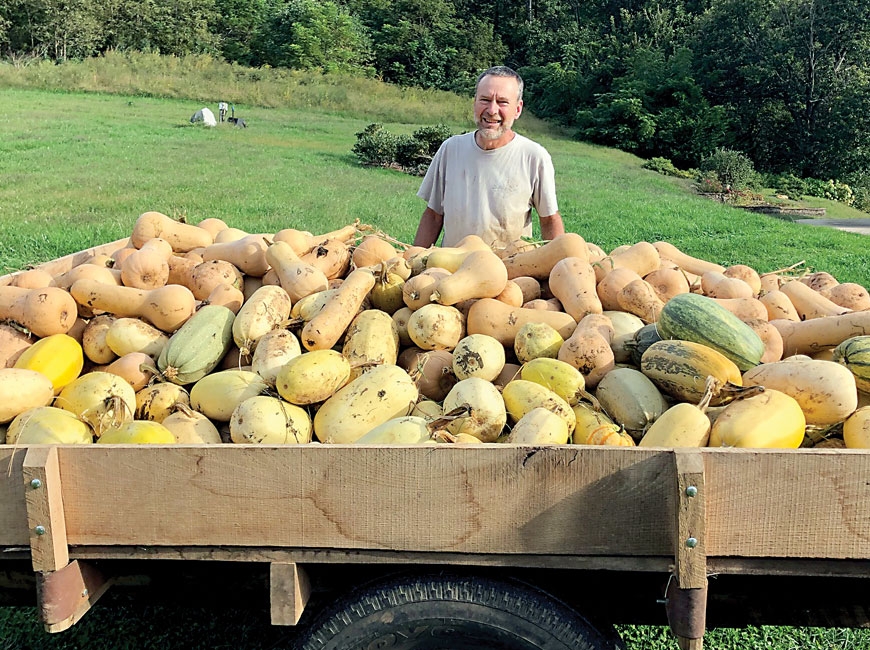‘Twice the work’: Farmers report higher-than-expected 2020 sales, but also higher costs
 Don Carringer poses with the winter squash harvest he brought in at Carringer Farms in Macon County. ASAP photo
Don Carringer poses with the winter squash harvest he brought in at Carringer Farms in Macon County. ASAP photo
When spring sprung in 2020, so did the Coronavirus Pandemic, forcing farmers to make life-altering decisions in the face of an unknown future. A recently published survey of Southern Appalachian farmers shows that those decisions built a reality that was better than anticipated but still full of challenges.
When the pandemic hit in March, the Appalachian Sustainable Agriculture Project quickly sent an online survey to 935 farmers and farmers market vendors operating within 100 miles of Asheville. Of those farmers, 85 — just 9 percent — responded by the deadline four days later. Their answers to its questions painted a grim picture . A full two-thirds said they expected decreased sales, financial hardship or bankruptcy over the next year, with 80 percent reporting immediate decreases in customers, sales and incomes. Only eight farmers, or 9.9 percent, said they expected sales to increase due to the pandemic.
A new survey, which opened on Oct. 29, 2020, and closed on Dec. 18, drew a higher response rate and a more optimistic vision of the future. Of 775 producers who received the survey link, 208 completed it for a response rate of 27 percent.
“To be a farmer you have to be optimistic, because every year, it’s not if something’s going to go wrong, but what’s going to go wrong this year,” said Molly Nicholie, co-director for ASAP. “Despite their fears, farmers really responded and pivoted their business models, knowing and being fearful of those different indicators we saw. So I was not surprised, but very pleased to see that really, there wasn’t a significant drop in total sales this year.”
Higher sales, higher costs
Gross sales were higher in 2020 than in 2019 for 47 percent of survey respondents, while 27 percent said gross sales were about the same and 26 percent reported lower gross sales. It’s an encouraging response compared to the fears encapsulated in the spring 2020 survey but indicates a decline in growth from 2019, when a similar ASAP survey showed 57 percent of farmers reporting higher gross sales than in the previous year.
Related Items
While many farmers saw higher or stable gross sales in 2020 compared to the previous season, they also grappled with increasing supply costs, supply chain issues and time-intensive pivots from previous market outlets and customer outreach strategies.
“A lot of what I heard anecdotally from farmers is, ‘Twice as much work to sell the same amount of product,’” said Nicholie.
Many farmers in the mountain region had already diversified their sales outlets prior to the pandemic, with ASAP’s 2019 survey showing that on average respondents sold to three different market outlets. However, 49 percent of farmers in that survey said that restaurants were one of those market outlets, and restaurants sales were the hardest hit in 2020. In ASAP’s fall 2020 survey, 74 percent of farmers reported decreased restaurant sales due to closures, downsizing and capacity limits. The proportion that said they sold to restaurants dropped down to 39 percent.
“We have only sold directly to chefs for over a decade,” said one respondent. “When the lockdown was implemented we had to quickly change our growing plan, and scramble for individual direct sales with delivery.”
The share of farmers selling at farm stores and stands as well as online markets increased compared to 2019, and most farmers who sold at farmers markets, farm stands, grocery stores, online, to distributors and wholesalers or through community supported agriculture and agritourism opportunities said that sales either increased or stayed the same compared to 2019.
But again, said Nicholie, it’s important to consider that these increased sales came within a context of higher materials costs; production challenges related to sourcing supplies, processing animals and hiring workers; and greater-than-ever demands on farmers’ time as they sought to retool their processes and business models to be pandemic-friendly.
“The sales and marketing piece of farming isn’t the part you see the pictures of, the images in the field, but it’s a huge amount of work, and often on top of all the production its really hard to put time to that,” said Nicholie.

A double rainbow arcs over Ten Acre Garden in Haywood County. ASAP photo
Reaching customers
In addition to entering new market outlets or expanding their footprint in existing outlets, farmers also had to find new ways to reach customers. In the 2019 survey, sampling products was rated as the most useful way to build customer relationships, with on-farm opportunities such as u-pick and tours coming in at number four and attending off-farm events such as food festivals and fairs at seven. Similarly, the most useful strategy for finding new buyers was meeting them at farmers markets, with on-farm events at number four, cold calls and drop-ins at six, attending Grower Buyer meetings at seven and attending off-farm events at eight.
Farmers had to adapt these strategies to pandemic life. In 2020, word of mouth from other farmers and recommendations from ASAP staff were the top two ways to find new buyers, and using social media and sharing your farm story the top two for building customer relationships.
However, some of those other seemingly less pandemic-friendly options were high in the mix as well. Meeting buyers at farmers markets, hosting on-farm events, attending grower-buyer meetings, attending off-farm events and cold calls/drop-ins were in third through eighth places, respectively, for finding new buyers. Sampling products, offering on-farm opportunities and attending off-farm events came in third, fourth and sixth places, respectively, for building customer relationships.
The season ahead
As the 2021 season begins, many questions remain, including how permanent some of the shifts farmers made to get through the pandemic — online stores, emphasis on direct sales, etc. — might turn out to be.
“I think this will be another critical year where restaurant sales are still not back online and things are not back to normal in terms of our market environment,” said Nicholie. “I don’t think we’ll have the answer to that this year.”
That said, it’s reasonable to guess that farms that had relied on selling large quantities of produce to restaurants prior to the pandemic would revert to that business model once the opportunity became available. Even if they have proven able to move that same amount of product through CSAs or on-farm sales, that approach takes more hands-on effort than filling larger bulk orders from restaurants. However, said Nicholie, the degree to which farms revert to their pre-pandemic normal will also depend on consumer behavior.
“The farmers’ shift in markets will really depend on how does that consumer behavior change,” said Nicholie. “As people continue to purchase that CSA year after year, then maybe that’s a model that’s going to be more viable. If that is more people that make a point to stop at the farm stand on their way home from work before they go to the grocery, if we see that behavior change, that will certainly influence what farmers choose to end up with as their market mix.”
The survey showed 42 percent of respondents saying that they will likely adjust their business plan in 2021 as a result of the pandemic, with an additional 37 percent saying that they may do so. The most common potential adjustments included increasing direct and online sales, increasing or diversifying production, or, conversely, reducing production.
Farming in Western North Carolina — and in the United States as a whole — was fragile before the pandemic. In a series of interviews The Smoky Mountain News conducted for a 2019 story , multiple farmers who had been in the business for decades lamented that the price of inputs like tractors, fertilizers and labor had escalated significantly since the beginning of their careers, even as wholesale market prices had remained stagnant and regulatory burden ballooned.
Given that context, it seemed almost a foregone conclusion that a massive crisis like the pandemic would knock a significant number of farmers out of business. But in response to ASAP’s survey, only 7 percent of respondents said their farm business would not be viable in 2021, with another 8 percent saying they weren’t sure at this time. Because the viability question isn’t part of ASAP’s previous annual survey, it’s difficult to compare that number against the typical turnover one might see in any industry year-to-year.
“If I was going to compare those numbers to anything else, it would be those numbers in the spring (2020),” said Nicholie. “I think people are more optimistic in general. We were able to make it through 2020. We will still be able to make it.”









